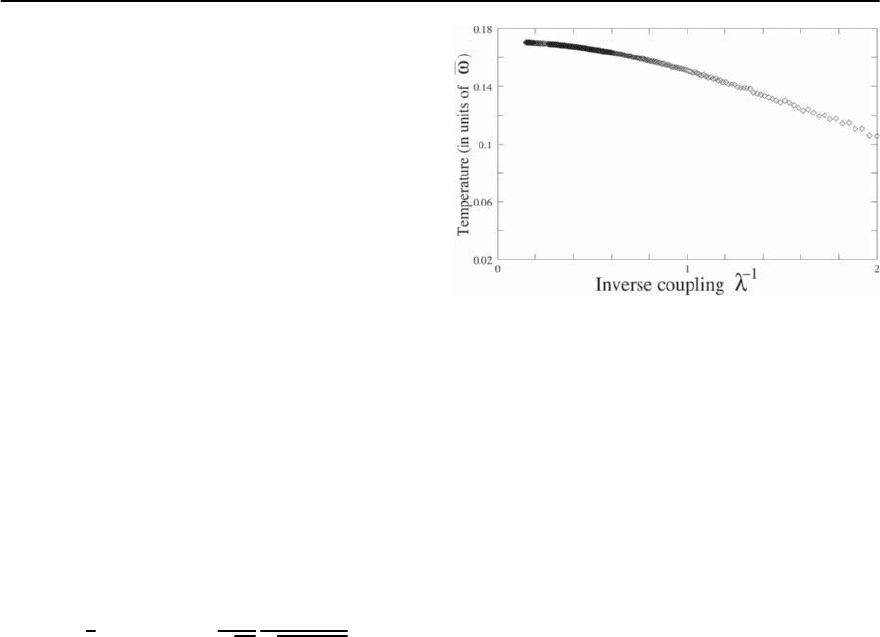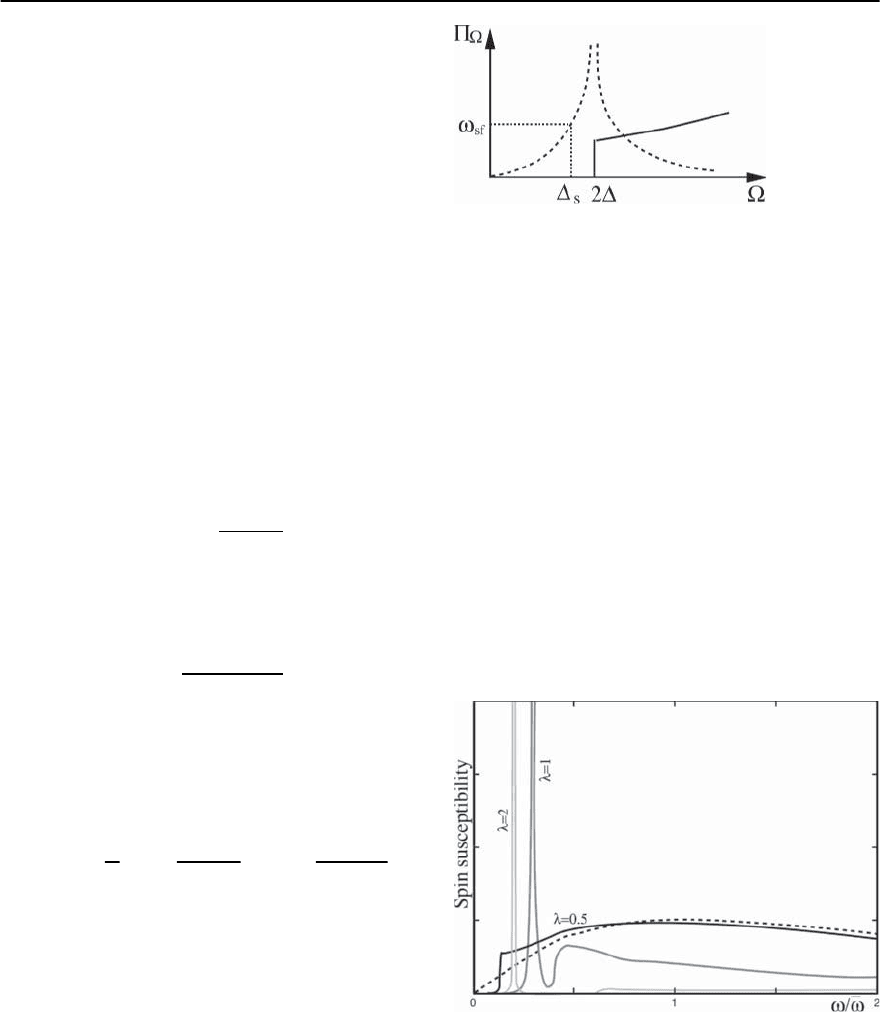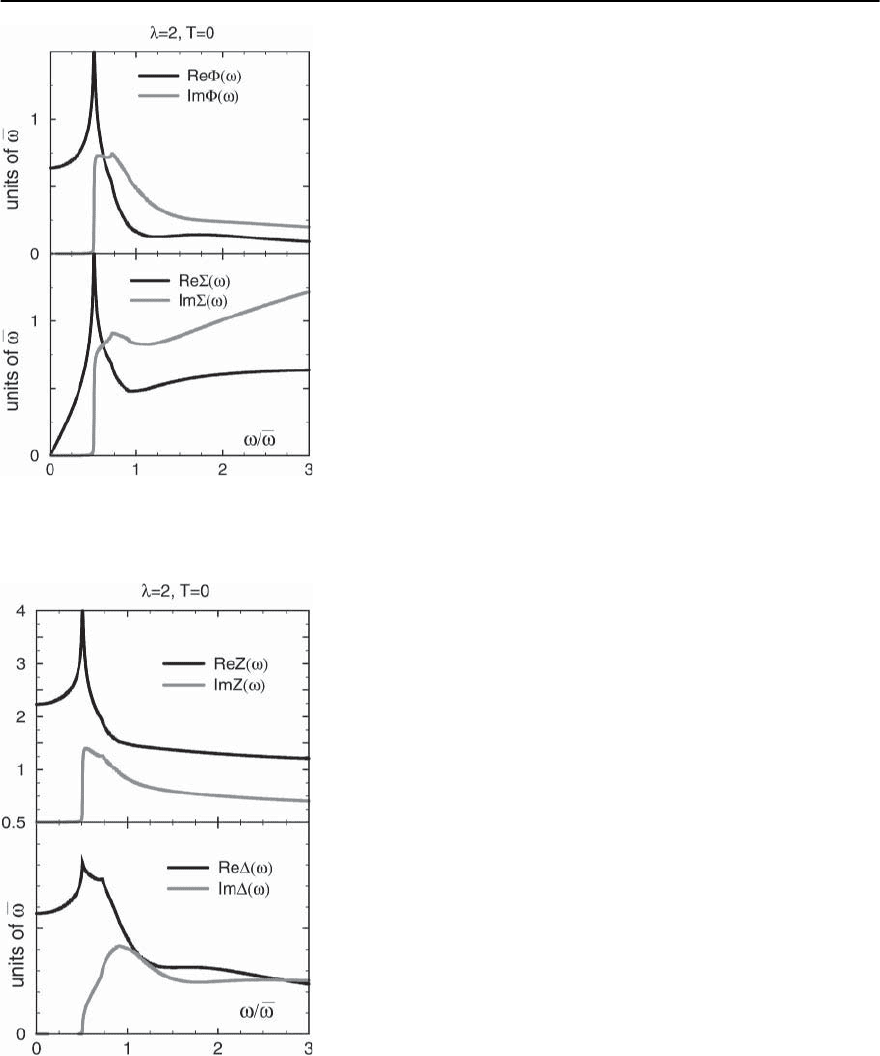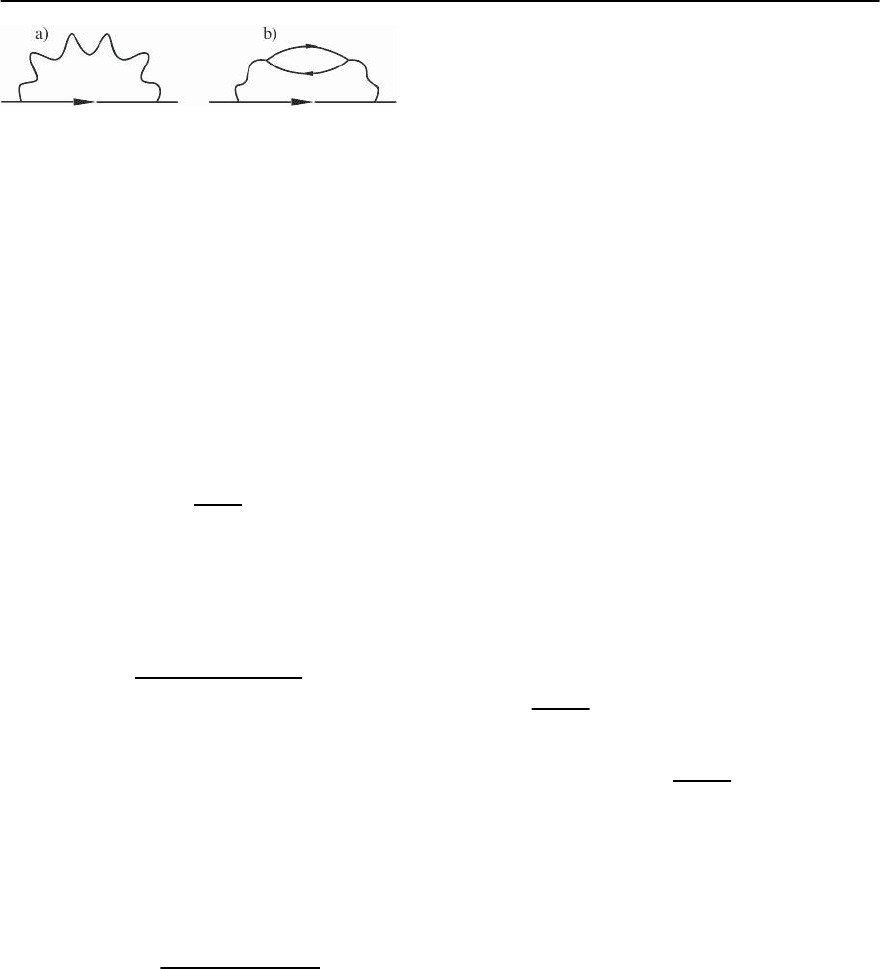Bennemann K.H., Ketterson J.B. Superconductivity: Volume 1: Conventional and Unconventional Superconductors; Volume 2: Novel Superconductors
Подождите немного. Документ загружается.


22 A Spin Fluctuation Model for d-Wave Superconductivity 1371
the effects caused by the incoherent nature of the
fermions are peculiar to 2d and are considerably less
pronounced in three-dimensional systems. In 22.8
results for the spectral function are given.
22.4.2 The d
x
2
−y
2
Pairing Instability Temperature
We now consider the development of the pairing in-
stability in the spin–fermion model. We follow [87].
It is customary in an analysis of the pairing prob-
lem to introduce an infinitesimally small particle–
particle vertex ¥
(0)
k,−k
(!, −!) ≡ ¥
(0)
k
(!)andstudy
its renormalization by the pairing interaction. The
corresponding diagrams are presented in Fig. 22.9.
Fig. 22.9. Diagrammatic representation for the pairing ver-
tex [87]. The solid and wavy lines are fermionic and spin-
fluctuation propagators, respectively
The temperature at which the renormalized vertex
diverges, i.e.when the equation for the full ¥
k
(!)has
a nontrivial solution at vanishing ¥
(0)
k
(!), marks the
onset of pairing. As noted above, the spin-mediated
pairing interaction gives rise to d
x
2
−y
2
superconduc-
tivity. We argued above that near the magnetic insta-
bility,the gap is maximum near the hot spots.Onecan
check (see [87]) that the pairing problem is confined
to the hot regions in the sense that the momentum
integration never extends to |k −k
hs
|∼k
F
,wherethe
momentum dependence of the self-energy or of the
pairing vertex becomes relevant.We can then assume
that the pairing vertex is flat near the hot spots. The
underlying d-wave symmetry then implies that the
gap changes sign between two hot regions separated
by the antiferromagnetic Q.
The momentum independence of the pairing
problem is due to the fact that, as we will see, the
pairing predominantly comes from frequencies of
order ¯g. For these frequencies, the width of the
hot region is constrained by the requirement that
!
sf
(k) < ¯g. The boundaries are set by !
sf
(k) ∼¯g,
i.e.by |k−k
hs
|∼k
F
(¯g /W ).Here,W is the bandwidth.
The condition |k − k
hs
| < k
F
then implies that the
effective coupling is smaller than the fermionic band-
width.As discussed in the Introduction, the latter is a
necessary condition for the separation between high
and low energies, and we assume it to hold. We com-
ment below on what happens if typical |k −k
hs
| > k
F
,
i.e. hot and cold regions cannot be separated.
The value of the transition temperature depends
sensitively on the behavior of fermions that are
paired by the spin-mediated interaction. Our anal-
ysis of the normal state has shown that the char-
acter of the fermionic degrees of freedom changes
at energies of order !
sf
. For energies smaller than
!
sf
, fermions display Fermi liquid behavior, whileat
higher energies they display behavior that is differ-
entfromthatinaFermiliquid.IntheBCStheoryof
superconductivity only Fermi liquid degrees of free-
dom contribute to the pairing. Let us suppose that
this also holds in the present case. Then the pair-
ing problem would be qualitatively similar to that of
BCS, since for frequencies smaller than !
sf
,thespin
susceptibility that mediates pairing can be approxi-
mated by its static value. The linearized equation for
the pairing vertex then has the form
¥
(
!
)
=
1+
!
sf
T
FL
c
d!
¥
(
!
)
!
, (22.56)
where the 1+ factorinthe denominator is the result
of mass renormalization in the Fermi liquid regime
(£(!) ≈ !). The solution of this equation [86]
yields
T
FL
c
∼ !
sf
exp
−
1+
. (22.57)
At weak coupling, this is just the BCS result. At
strong coupling, the mass renormalization compen-
sates the coupling constant, and T
FL
c
saturates at
T
FL
c
∼ !
sf
∝
−2
.Thisresult,ifcorrect,wouldimply
that the pairing fluctuations become progressively
less relevant as one approaches the quantum critical
point
−1
→ 0(seetheleftpanelin Fig.22.5).Ata first
glance, this is what happens, because pairing of non
Fermi-liquid degrees of freedom seems hard to ac-
complish. Indeed, at frequencies larger than !
sf
,the
pairing interaction decreases as (1 + |!
m
|/!
sf
)
−1/2
,

1372 A.V. Chubukov, D. Pines, and J. Schmalian
and this apparently makes the frequency integral ul-
traviolet convergent, i.e. the “logarithmic” pairing
problem does not appear to extend above !
sf
.The
flaw in this argument is that when the interaction
decreases,the mass renormalization produced by the
same interaction also decreases, and the large overall
is no longer compensated by 1 + £(i!
m
)/i!
m
.In-
deed, for !
m
!
sf
, £(i!
m
)=i( ¯!!
m
)
1/2
,where,we
recall, ¯! =(9/16)¯g, and the mass renormalization
is 1+( ¯!/!
m
)
1/2
=1+2(!
sf
/!
m
)
1/2
.Further-
more, we see that at frequencies between !
sf
and
¯!, the effective mass and effective interaction both
scale as (!)
−1/2
. The product of the two then scales
as 1/!,i.e.the1/!
m
behavior of the pairing kernel
extends to frequencies of the order of ¯! which, we
recall, remains finite at = ∞.
By itself, this effect does not guarantee that the
pairing instability temperature is of order ¯! as the
pairing interaction depends on the transferred fre-
quency ! − !
, and the linearized equation for the
pairing vertex becomes an integral equation in fre-
quency. In particular, for = ∞, and hence !
sf
=0,
we need to solve
¥
(
!
)
=
1
4
¯!
T
cr
d!
¥
!
1
√
!
1
√
|! − !
|
. (22.58)
Observe that this equation does not have any ad-
justable parameter and is therefore fully universal
when T is expressed in units of ¯!. Equation (22.58)
has been analyzed in detail by Finkel’stein, Abanov
and one of us [87]. They found that it does have a
nontrivial solution at
T
cr
∼ 0.2 ¯! . (22.59)
They also analyzed the pairing problem at a finite
and found that incoherent fermions dominate pair-
ing down to a surprisingly small ∼ 0.5. The
McMillan like formula, (22.57), becomes valid only
at smaller . A plot of T
cr
versus is presented in
Fig. 22.10.
Several comments are in order here.First, at these
values of the coupling constant (and doping) T
cr
does not coincide with the onset temperature for
superconductivity, T
c
, but rather represents the on-
Fig. 22.10. The results for the instability temperature T
cr
obtained from the solution of the linearized Eliashberg
equations for different values of the coupling constant .
The figure is taken from [87]
set temperature for pseudogap behavior; the ac-
tual T
c
is lower, as discussed below. Second, we
have neglected fluctuation effects due to the quasi-
two-dimensionality. The latter are expected to yield
Kosterlitz–Thouless physics [126]. Third, (22.59), is
only valid when ¯g < W. In the opposite limit ¯g > W,
lattice effects are important and controlledanalytical
calculations are difficult to perform. One can, how-
ever, easily estimate that in this limit T
cr
∝ v
2
F
/¯g ∝
!
sf
2
(we set interatomic spacing a =1).Thisesti-
matecoincideswiththeresultof Monthoux andPines
who extracted T
cr
∝ !
sf
2
from their numerical
analysis [37].Since v
F
is proportional to the hopping
matrix element, and ¯g scales with the Hubbard U,it
follows that for U >> W,the spin-mediated pairing
yields T
cr
∝ J,whereJ is the magnetic exchange in-
tegral of the correspondingHeisenberg model which
describes antiferromagnetism at half-filling.
Equation (22.59) demonstrates that the d-wave
pairing instability temperature of a two dimensional
system at an antiferromagnetic quantum critical
point is finite. The behavior near a ferromagnetic
quantum-critical point is more complex, see [88].
22.4.3 Superconducting State
We next extend the Eliashberg theory to the spin-
fluctuation induced superconducting state. The dis-
cussion in this section follows [89].We derive a gen-
eralized set of Eliashberg equations for the fermionic

22 A Spin Fluctuation Model for d-Wave Superconductivity 1373
self-energy and the gap function that include an ad-
ditional coupled equation for the spin polarization
operator.The latter, as discussed in the Introduction,
is produced by low-energy fermions and has to be
determined self consistently.
We will see that in the superconducting state, the
momentum integration is also confined to hot re-
gions |k − k
hs
|∼k
F
(¯g/W) ≤ k
F
.Wecanthen safely
neglect the weak momentum dependence of both
£(i!)and¥ (i!), as we did above in calculating
T
cr
. Subtle effects due to this weak momentum de-
pendence will be considered in the next section. We
will not attempt to discuss the behavior of the gap
near the nodes. The nodal behavior is central for the
interpretation of the experimental data at the low-
est temperatures and frequencies,but not at energies
comparable or larger than the maximum pairing gap
which we consider below.
Generalized Eliashberg Equations
The derivation of the Eliashberg equations is
straightforward. In the superconducting state, the
normal and anomalous fermionic Green’s functions
G
k
(
i!
n
)
and F
k
(
i!
n
)
and the dynamical spin sus-
ceptibilityaregiven by (22.9)–(22.11).It isconvenient
to rewrite G
k
(
i!
n
)
and F
k
(
i!
n
)
as
G
k
(
i!
n
)
=−
k
+ i
£
n
2
k
+
£
2
n
+ ¥
2
(i!
n
)
,
F
k
(
i!
n
)
= i
¥ (i!
n
)
2
k
+
£
2
n
+ ¥
2
(i!
n
)
, (22.60)
F
k+Q
(
i!
n
)
=−i
¥ (i!
n
)
2
k+Q
+
£
2
n
+ ¥
2
(i!
n
)
,
where i
£
n
= i!
n
+ £
k
hs
(
i!
n
)
(in real frequencies,
£(!)=! + £
k
hs
(!)). Without losing generality we
can set
k
= v
x
˜
k
x
+ v
y
˜
k
y
and
k+Q
=−v
x
˜
k
x
+ v
y
˜
k
y
where
˜
k = k − k
hs
. The sign change between F
k
and
F
k+Q
is the result of d
x
2
−y
2
symmetry. The spin sus-
ceptibility, we recall,is given by
q
(
i!
m
)
=
˛
2
1+
2
(
q − Q
)
2
− ¢
Q
(
i!
m
)
. (22.61)
We need to obtain the equations for the
fermionic self-energy £
k
hs
(i!
m
), the anomalous ver-
tex ¥
k
hs
(i!
m
), and the spin polarization operator
¢
Q
(i!
m
). The spin polarization operator is obtained
in the same way as in the normal state, but now there
are two particle–hole bubbles: one is the convolution
of G
k
G
k+Q
and the other is the convolutionof F
k
F
k+Q
.
We have
¢
Q
(
i!
n
)
=−16¯g
2
T
m
d
2
k
(
2
)
2
(22.62)
×
G
k+Q
(
i!
n+m
)
G
k
(
i!
m
)
− F
k+Q
(
i!
n+m
)
F
k
(
i!
m
)
(the negative sign between the two terms originates
in the summation over the spin components). The
momentum integration can be performed explicitly
and yields
¢
Q
(
i!
n
)
=−
4¯g
2
v
2
F
T
m
1−g
(
i!
m
)
g
(
i!
n+m
)
− f
(
i!
m
)
f
(
i!
n+m
)
, (22.63)
where
g
(
i!
m
)
=
£
m
£
2
m
+ ¥
2
(i!
m
)
, (22.64)
and
f
(
i!
m
)
=
¥ (i!
m
)
˜
£
2
m
+ ¥
2
(i!
m
)
. (22.65)
The first term in (22.63) is the result of the regular-
ization of the ultraviolet singularity. The minus sign
factor in f
(
i!
m
)
f
(
i!
n+m
)
term in (22.63) is due to
the d-wave form of F
k
.
Equation (22.63) takes into account the change of
the low energy spin dynamics in the pairing state.
In the case of electron–phonon interaction a corre-
sponding change of the phonon dynamics exists as
well, causing a shift of the phonon frequency and
line width below T
c
.While this effect is only a minor
correction to the phononic dynamics and is often ne-
glected [117],it eads to a dramatic change of the spin
dynamics in our case.
The other two equations are formally the
same as for phonon-mediated superconductors. The
fermionic self-energy £(!
n
)isgivenby

1374 A.V. Chubukov, D. Pines, and J. Schmalian
£
(
i!
n
)
=−3g
2
T
m
d
2
q
(
2
)
2
(
q, i!
m
)
×G
k+q
(
!
n+m
)
. (22.66)
Performing the momentum integration along the
samelinesasinthenormalstatecalculationswefind
£
(
i!
n
)
=
3g
2
2v
F
T
m
D
(
i!
m
)
g
(
i!
n
+ i!
m
)
,
(22.67)
whereD istheeffective bosonic propagator thatisob-
tained by integratingthe dynamical spin susceptibil-
ity over the momentum component along the Fermi
surface and setting other momentum components to
Q (the last step is equivalent to the approximation we
discussed below (22.42)). We have
D
(
i!
m
)
=
dq
2
(
q, i!
m
)
q
⊥
=Q
=
˛
2
1−¢
Q
(
i!
m
)
. (22.68)
An analogous equationis obtainedfor theanomalous
vertex
¥ (i!
n
)=
3g
2
2v
F
T
m
D
(
i!
m
)
f
(
i!
n
+ i!
m
)
. (22.69)
Equations (22.63), (22.67), and(22.69) constitute the
full set of Eliashberg equations for the spin-mediated
superconductivity. Alternatively to ¥ (!)and£(!)
we can also introduce
Z(!)=1+
£(!)
!
, (!)=
¥ (!)
Z(!)
. (22.70)
The complex function (!) reduces to the super-
conducting gap in BCS theory where we also have
Z(!) = 1. In Eliashberg theory, the superconduct-
ing gap, defined as a frequency where the density of
states has a peak, is the solution of (! = )=!.
We again emphasize that the Eliashberg equa-
tions are valid for fermionic momenta which devi-
ate from hot spots by less than ¯g/W. For these mo-
menta, the pairing vertex can be approximated by a
k-independent function which however changes sign
between two hot regions separated by Q.Forlarger
deviations, the anomalous vertex rapidly goes down
and eventually vanishes along zone diagonals.
Solution of the Eliashberg Equations
We discuss the general structure of the solutions of
the set of Eliashberg equations, and then present the
results of their numerical solution. First, we see from
(22.63) that, as in the normal state, ¢(! = 0) = 0 for
any £(!)and¥ (!). This physically implies that the
development of the gap does not change the mag-
netic correlation length.This result becomes evident
if one notices that d-wave pairing involves fermions
from opposite sub-lattices. Second, the opening of
the superconducting gap changes the low frequency
spin dynamics. Now quasiparticles near hot spots
are gapped, and a spin fluctuation can decay into
a particle–hole pair only when it can pull two par-
ticles out of the condensate of Cooper pairs. This
implies that the decay into particle–hole excitations
is only possible if the external frequency is larger
than 2. At smaller frequencies, we should have
¢
(!)=0atT = 0 [123, 128]. This result indeed
readily follows from (22.63). The Kramers–Kronig
relation ¢
(!)=(2/)
∞
0
¢
(x)/(x
2
− !
2
)then
implies that because of a drop in ¢
(!), the spin po-
larization operator in a superconductor acquires a
real part, which at low ! is quadratic in frequency
and is of order !
2
/(!
sf
). Substituting this result
into (22.11), we find that at low energies, spin exci-
tations in a d-wave superconductor are propagating,
gapped magnon-like quasiparticles
(q, !) ∝
2
s
2
s
+ c
2
s
(q − Q)
2
− !
2
, (22.71)
where
s
∼ (!
sf
)
1/2
(22.72)
and c
2
s
∼ v
2
F
/¯g. The re-emergence of propagating
spin dynamics implies that the dynamical spin sus-
ceptibility acquires a resonance peak which at q = Q
is located at ! =
s
.
Equation(22.71)isindeedmeaningfulonlyif
s
≤
,i.e.!
sf
≤ . Otherwise the use of the quadratic
form for ¢(!) is not justified. To find out how
depends on the coupling constant, one needs to care-
fully analyze the full set of equations (22.63)–(22.69).
This analysis is rather involved [87,89],andis not di-
rectly related to the goal of this chapter.We skip the

22 A Spin Fluctuation Model for d-Wave Superconductivity 1375
details and quotethe result.It turns outthat at strong
coupling, ≥ 1, i.e. for optimally and underdoped
cuprates, the condition > !
sf
is satisfied: the gap
scales with ¯! and saturates at ≈ 0.35 ¯! =0.06¯g
at →∞,while!
sf
∝
−2
→ 0. In this situation,
the spin excitations in a superconductor are propa-
gating, particle-like modes with a gap
s
.However,in
distinction to phonons, these propagating magnons
get their identity from a strong coupling feedback
effect in the superconducting state.
At weak coupling, the superconducting problem
is of the BCS type, and !
sf
.Thisresultisin-
tuitively obvious as !
sf
plays the role of the Debye
frequency in the sense that the bosonic mode that
mediates pairing decreases at frequencies above !
sf
.
For !
sf
, (Q, !) does not have a pole at fre-
quencies where ¢(!) ∝ !
2
. Still, a pole in
(Q, !)
does exist even at weak coupling [123,128–132]. To
see this, note that at ! ≈ 2 one can simultane-
ously set both fermionic frequencies in the bubble to
be close to , and make both propagators singular
due to the vanishing of
˜
£
2
− ¥
2
where, we recall,
˜
£ = ! + £(!). Substituting
˜
£
2
(!)−¥
2
(!) ∝ ! −
into (22.63)and using the spectral representation,we
obtain for ! =2 +
¢
(!) ∝
0
dx
(x( − x))
1/2
. (22.73)
Evaluating the integral, we find that ¢
undergoes a
finite jump at ! =2. By the Kramers–Kronig rela-
tion,this jump gives rise to a logarithmic singularity
in ¢
(!)at! =2:
¢
(!)=
2
∞
2
dx
¢
(x)
x
2
− !
2
∝ log
2
|! −2|
.
(22.74)
The behavior of ¢
(!)and¢
(!) is schematically
shown in Fig. 22.11.
The fact that ¢
(!) diverges logarithmically at 2
implies that no matter how small /!
sf
is, (Q, !)
has a pole at
s
< 2,when¢
(!) is still zero.
Simple estimates show that for weak coupling, where
!
sf
, the singularity occurs at
s
=2(1 − Z
s
)
where Z
s
∝ e
−!
sf
/(2)
is also the spectral weight of
the resonance peak in this limit.
Fig. 22.11. Schematic behavior of the real (dashed line)and
imaginary (solid line) parts of the particle hole bubble in
the superconducting state. Due to the discontinuous be-
havior of ¢
(
!
)
at ! =2, the real part ¢
(!)islogarith-
mically divergent at 2.Forsmall!, the real part behaves
like !
2
/. The figure is taken from [133]
We see therefore that the resonance in the spin
susceptibility exists both at weak and at strong cou-
pling. At strong coupling, the resonance frequency
is
s
∼ / , i.e. the resonance occurs in the
frequency range where spin excitations behave as
propagating magnon-like excitations. At weak cou-
pling, the resonance occurs very near 2 due to the
logarithmic singularity in ¢
(!). In practice, how-
ever, the resonance at weak coupling can hardly be
observed because the residue of the peak in the spin
susceptibility Z
s
is exponentially small.
Figure 22.12 shows the results for (Q, !)ob-
tained from the full solution of the set of three cou-
Fig. 22.12. Imaginary part of the dynamical spin suscep-
tibility in the superconducting state at T T
c
obtained
from the solution of the set of three Eliashberg equations
for coupling constants =0.5, =1,and =2.Thefigure
is taken from [133]

1376 A.V. Chubukov, D. Pines, and J. Schmalian
pled equations at T ≈ 0 and three different coupling
constants [89].For ≥ 1, the spin susceptibility has
a sharp peak at ! =
s
. The peak gets sharper when
it moves away from 2.At the same time, for =0.5,
corresponding to weak coupling, the peak is very
weak and is washed out by a small thermal damping.
In this case,
only displays a discontinuity at 2.
We next show that the resonance peak does not
exist for s-wave superconductors [134]. In the latter
case, the spin polarization operator is given by al-
most the same expression as in (22.63), but with a
different sign of the ff -term; recall that the origi-
nal sign in (22.63) originated from the fact that the
two fermions in the spin polarization bubble differ
in momentum by Q,andthed-wave gap changes
sign under k → k + Q. One can immediately check
that for a different sign of the anomalous term, ¢
is continuous at 2.Accordingly,¢
(!)doesnotdi-
verge at 2, and hence there is no resonance at weak
coupling. Still, however, one could expect the res-
onance at strong coupling as at small frequencies
¢
(!) is quadratic in ! by virtue of the existence of
the threshold for ¢
. It turns out, however, that for
s-wave pairing the resonance is precluded by the fact
that ¢(! = 0) becomes finite and negative in the
superconducting state.This negative term overshad-
ows the positive !
2
term in ¢(!)insuchawaythat
for all frequencies below2,¢(!) < 0 and hence the
resonance simply does not exist. That ¢(! =0)< 0
in s-wave superconductors can be easily explained: a
negative ¢(0) implies that thespincorrelation length
decreases as the system becomes superconducting.
This is exactly what one should expect as s-wave pair-
ing involves fermions both from different magnetic
sub-lattices as well as from the same sub-lattice. The
pairing of fermions from the same sub-lattice into
a spin-singlet state obviously reduces the antiferro-
magnetic correlation length. The d-wave pairing, on
the contrary, only involves fermions from different
sub-lattices, and ¢(! =0)=0.
We also comment on the dispersion of the reso-
nance peak. In (22.71) we assumed that
s
is a con-
stant. In fact,
s
depends on q since for any given q,
2
s
∝ (q)where(q)isad-wave gap at the points at
the Fermi surface which are connected by q.Inpar-
ticular,
s
should vanish at q = Q
min
which connects
the nodal points. This effect accounts for the “nega-
tive”dispersion of the resonance peak [129,134].The
latter certainly overshadows the positive dispersion
due to (q − Q)
2
term for q close to Q
min
and may do
so even for q near Q if the correlation length is not
large enough. This effect is, however, not a part of
the quantum-critical description (it should become
progressively less relevant for q = Q
min
when in-
creases), and we ignore it in the subsequent analysis.
Note, however, that the negative dispersion of the
peak implies that the peak exists only for a small
range of momenta between Q and Q
min
. In optimally
doped cuprates, Q
min
≈ (0.8, 0.8) [136,137],and
the momentum range for the peak does not ex-
ceed 4% of the Brillouin zone. The actual q re-
gion where the peak is observable is even smaller
as the intensity of the peak also decreases when q
approaches Q
min
. The smallness of the q-range for
the peak accounts for small overall spectral inten-
sity I
0
=
S(q, !)d
2
qd!/(2)
3
that turns out to
be substantially smaller than S(S +1)/3=1/4. Still,
at Q, the intensity of the peak is not small (exper-
imentally,
S(Q, !)d! ∼ 1.5 in optimally doped
YBCO [138,139]), and we have verified that for the
frequencies that we consider below, the typical q − Q
that account for the feedback on the fermions are
well within the q range between Q and Q
min
.Inother
words, the small overall intensity of the resonance
peak does not preclude strong feedback effects from
the resonance peak on fermionic variables.
For completeness, in Figs. 22.13 and 22.14 we
present results for the fermionic self-energy and the
pairing vertex for the smallest T. We see that the
real parts of ¥ (!)and(!) are finite at ! =0
as should be the case in the superconducting state.
The imaginary parts of¥ (!)and£(!)(andof(!)
and Z(!)) vanish at small frequencies and appear
only above the threshold frequency that is precisely
+
s
. Furthermore, all variables have a complex
internal structure at large frequencies. In the next
section we discuss the physical origin of the thresh-
old at +
s
and also show that one can extract 3
from the derivative of £
(!).
Few words about the numbers. For =2, ≈
0.3 ¯! and
s
≈ 0.2 ¯!,i.e. and
s
are comparable
to each other. For 1anumericalsolutionofthe

22 A Spin Fluctuation Model for d-Wave Superconductivity 1377
Fig. 22.13. The real and imaginary parts of the fermionic
self-energy £(!) and the pairing vertex ¥ (!)for =2
and the lowest T. The results are from [135]
Fig. 22.14. The real and imaginary parts of the effective gap
(!) and the quasiparticle renormalization factor Z(!)
for =2andthelowestT. The results are from [135]
Eliashberg equations leads to ∼ 2T
cr
∼ 0.35 ¯!,and
s
∼ 0.25 ¯!/ .
22.5 Fingerprints of Spin Fermion Pairing
In this Section, we discuss the extent to which the
“fingerprints” of spin-mediated pairing can be ex-
tracted from experiments on materials that are can-
didates for a magnetically-mediatedsuperconductiv-
ity. Due to strong spin–fermion coupling, there is
unusually strong feedback from spin excitations on
fermions, specific to d-wave superconductors. The
origin of this feedback is the emergence of a propa-
gating collective spin bosonic mode below T
cr
.This
mode is present for any coupling strength,and its gap
s
is smaller than the minimum energy ∼ 2 that is
necessary to break a Cooper pair. In the vicinity of
the antiferromagnetic phase,
s
∝
−1
where is the
magnetic correlation length.We show that this prop-
agating spin mode changes the onset frequency for
single particle scattering, gives rise to the“peak-dip-
hump”featuresin the quasiparticlespectral function,
the“dip-peak”features in tunneling SIS and SIN con-
ductances, and to singularities and fine structures in
the optical conductivity.In Sect. 22.6, we apply these
results to cuprate superconductors and argue that (i)
thesefeatureshave been observed [136,137,140–145],
(ii) ARPES [136,137,140,141], tunneling [142,143],
and conductivity data [144,145] are consistent with
each other, and (iii) the value of
s
extracted from
these various experiments coincides with the reso-
nance frequency measured directly in neutron scat-
tering experiments [138,139,146].
22.5.1 The Ph ysical Origin of the Effect
The physical effect that accounts for dips and humps
in the density of states and spectral function of
cuprates is not new and is known for conven-
tional s -wave superconductors as the Holstein ef-
fect [5,147,148]. Consider a clean s-wave supercon-
ductor, and suppose that the residual interaction be-
tween fermions occurs via the exchange of an Ein-
stein phonon. Assume for simplicity that the fully

1378 A.V. Chubukov, D. Pines, and J. Schmalian
Fig. 22.15. (a) The exchange diagram for a boson medi-
ated interaction. The solid line stands for a propagating
fermion. The wiggly line is a phonon propagator in the
case of electron–phonon interaction, and a magnon line
in the case of a spin-fluctuation mediated interaction. (b)
The lowest order diagram for the fermionic self energy due
to a direct four fermion interaction, also represented by a
wiggly line. The figure is taken from [133]
renormalized electron phonon coupling is some con-
stant g
ep
, and that the phonon propagator D(q, !)
is independent of momentum q and has a sin-
gle pole at a phonon frequency !
0
(the Holstein
model [147–149]). Phonon exchange gives rise to
a fermionic self-energy (see Fig. 22.15(a))
£(i!
m
)=−g
2
ep
T
n
d
d
k
(2)
d
G
k
(i!
n
)D(i!
m
−i!
n
) ,
(22.75)
whichis a convolutionof D(!)=1/(!
2
0
−(! +i0
+
)
2
)
with the full fermionic propagator G
k
(!), which in a
superconductor is given by (22.9):
G
k
(!)=
˜
£(!)+"
k
˜
£(!)
2
− ¥
2
(!)−"
2
k
. (22.76)
As before, ¥ (!) is the pairing vertex, and "
k
is the
band dispersion of the fermions. At T =0both
£
(!)and¥
(!) obviously vanish for ! ≤ .
This implies that the fermionic spectral function
A
k
(!)=
G
k
(!)
/ for particles at the Fermi sur-
face (k = k
F
)hasaı-function peak at ! = ,i.e.
is a sharp gap at zero temperature. The fermionic
density of states in a superconductor
N(!)=N
0
Im
$
˜
£(!)
(¥
2
(!)−
˜
£
2
(!))
1/2
&
(22.77)
vanishes for ! < and has a square root singularity
N(!) ∝ (! − )
−1/2
for frequencies above the gap
(N
0
is the normal state density of states).
The onset of the imaginary part of the self-energy,
(22.75), can be easily obtained by using the spectral
representation for fermionic and bosonic propaga-
tors in (22.75) and re-expressing the momentum in-
tegration in terms of an integration over "
k
.AtT =0
we obtain
£
(! > 0) ∝
!
0
d!
N(!
)D
(! − !
) . (22.78)
Since for positive frequencies, D
(!)=(D
0
/2!
0
)
×ı(! −!
0
),the frequency integration is elementary
and yields
£
(! > 0) ∝ N(! − !
0
) . (22.79)
We see that the single particle scattering rate is di-
rectly proportional to the density of states shifted
by the phonon frequency.Clearly,the imaginary part
of the fermionic self-energy emerges only when !
exceeds the threshold
§
t
≡ + !
0
, (22.80)
which is the sum of the superconducting gap and
the phonon frequency. Right above this threshold,
˜
£
(!) ∝ (! − §
t
)
−1/2
. By the Kramers–Kronig re-
lation, this non-analyticity causes a square root di-
vergence of
˜
£
(!)at! < §
t
. Combining the two
results, we find that near the threshold,
˜
£(!)=
A + C/
√
§
t
− ! where A and C are real numbers.
Bythesamereasoning,thepairingvertex¥ (!)
also possesses a square root singularity at §
t
.Near
! = §
t
, ¥ (!)=B + C/
√
§
t
− ! with real B.Since
§
t
> ,wehaveA > B.
The singularity in the fermionic self-energy gives
rise to an extra dip-hump structure of the fermionic
spectral function at k = k
F
.Below§
t
,thespec-
tral function is zero except for ! = ,where
it has a ı-functional peak. Immediately above §
t
,
A(!) ∝ Im(
˜
£(!)/(
˜
£
2
(!)−¥
2
(!))) takes the form
A(!) ∝ (! − §
t
)
1/2
. At larger frequencies, A(!)
passes through a maximum,and eventually vanishes.
Adding a small damping introduced by either impu-
rities or finite temperatures, one obtains the spectral
functionwith apeak at ! = ,adipat! ≈ §
t
,anda
hump at a somewhat larger frequency. This behavior
is shown schematically in Fig. 22.16.

22 A Spin Fluctuation Model for d-Wave Superconductivity 1379
Fig. 22.16. The schematic form of the quasiparticle spec-
tralfunctionin ans-wavesuperconductor. Solid line:T =0.
Dashed line: at finite T. §
t
= + !
0
(from [133])
The singularities in
˜
£(!)and¥ (!) affect other
observables such as the fermionic DOS, optical con-
ductivity,Raman response,and the SIS tunneling dy-
namical conductance [148,150].
For a more complex phonon propagator, which
depends on both frequency and momentum,the sin-
gularities in the fermionic self-energy and other ob-
servables are weaker and may only show up in the
derivatives over frequency [4,151]. Still, the opening
of the new relaxationalchannel at §
t
gives risetosin-
gularities in the electronic properties of a phonon-
mediated s-wave superconductor.
22.5.2 Similarities and Discrepancies Betw een d-Wave
and s-Wave-Superconductors
As we already discussed, for magnetically mediated
d-wave superconductivity,spin fluctuations play the
role of phonons. Below T
c
, spin excitations are prop-
agating,magnon-like modes with the gap
s
.This
s
obviouslyplaysthesameroleas!
0
for phonons,and
hence we expect that for spin-mediated pairing, the
spectral function should display a peak-dip-hump
structure as well. Furthermore, we will demonstrate
below that for observables such as the DOS, Raman
intensityandthe opticalconductivity,whichmeasure
the response averaged over the Fermi surface, the an-
gular dependence of the d-wave gap () ∝ cos
(
2
)
softens the singularities, but does not wash them
out over a finite frequency range. Indeed, we will
find that the positions of the singularities are not
determined by some averaged gap amplitude but by
the maximum value of the d-wave gap,
max
= ,
i.e. the Holstein effect is still present for a d-wave
superconductor.
Despite many similarities, the feedback effects for
s-wave and d-wave superconductors are not equiva-
lent as we now demonstrate. The point is that for s-
wave superconductors, the exchange process shown
in Fig. 22.15(a) is not the only possible source for
the fermionic decay; there exists another process,
shown in Fig. 22.15(b), in which a fermion decays
into three other fermions. This process is due to a
residual four-fermion interaction [148,150].Onecan
easily make sure that this second process also gives
rise to the fermionic decay when the external ! ex-
ceeds a minimum energy of 3, necessary to pull all
three intermediate particles out of the condensate of
Cooper pairs. At the threshold, the fermionic spec-
tral function is non-analytic, much like that found
at + !
0
.Thisimpliesthatins-wave superconduc-
tors, there are two physically distinct singularities,at
+ !
0
and at 3, which come from different pro-
cesses and therefore are independent of each other.
Which of the two threshold frequencies is larger de-
pends on the strength of the coupling and on the
shape of the phonon density of states. At weak cou-
pling, !
0
is exponentially larger than ,hence the 3
threshold comes first. At strong coupling, !
0
and
are comparable, but calculations within the Eliash-
berg formalism show that for real materials (e.g. for
lead or niobium), still3 < + !
0
[152].This result
is fully consistent with the photoemission data for
these materials [153].
For magnetically mediated d-wave superconduc-
tors the situation is different. As we discussed in
Sect. 22.2,in the one-band model for cuprates,which
we adopt, the underlying interaction is a Hubbard-
type four-fermion interaction. The introduction of
a spin fluctuation as an extra degree of freedom is
just a way to account for the fact that there exists
a particular interaction channel, where the effective
interaction between fermions is the strongest due
to the proximity to a magnetic instability. This im-
plies that the spin fluctuation propagator is made out
of particle–hole bubbles like those in Fig. 22.15(b).
Then, to the lowest order in the interaction, the
fermionic self-energy is given by the diagram in
Fig.22.15(b).Higher-order terms convert a particle–

1380 A.V. Chubukov, D. Pines, and J. Schmalian
hole bubble in Fig. 22.15(b). into a wiggly line, and
transform this diagram into the one in Fig. 22.15(a).
Clearly then, inclusion of both diagrams would be
double counting, i.e. there is only a single process
which gives rise to the threshold in the fermionic
self-energy. We will show that this process generates
two singularities: at 3,andat +
s
< 3.The
fact that this is an internal effect implies that
s
de-
pends on . The experimental verification of this de-
pendence can then be considered as a “fingerprint”
of the spin-fluctuation mechanism. Furthermore, as
the singularities at 3 and +
s
are due to the
same interaction, their relative intensity is another
gauge of the magnetic mechanism for the pairing.We
will argue below that some experiments on cuprates,
particularly measurements of the optical conductiv-
ity [145],allow one to detect both singularities, and
that their calculated relative intensity is consistent
with the data.
We now discuss separately the behavior of the
electronic spectral function, the density of states, SIS
tunneling, the Raman intensity and the optical con-
ductivity. To account for all features associated with
d-wave pairing, we will keep the momentum depen-
dence of the fermionic self-energy and the pairing
vertex onmomenta along the Fermi surface,although
this dependence is indeed weak near hot spots. For
simplicity, we assume a circular Fermi surface. In
this situation, the k-dependence of the self-energy
and the pairing vertex reduces to the angular depen-
dence, i.e. £ = £(, !)and¥ = ¥ (, !).
22.5.3 The Spectral Function
We first consider the spectral function A
k
(!)=
(1/)|G
k
(!)|. In the superconducting state, for
quasiparticles near the Fermi surface
A
k
(! > 0) =
1
Im (22.81)
×
$
! + £(, !)+"
k
(
! + £(, !)
)
2
− ¥
2
(, !)−"
2
k
&
.
By definition, A
k
(−!)=A
k
(!).
In a Fermi gas with d-wave pairing, £(, !)=0,
and ¥ (, !)=() ∝ cos
(
2
)
.Thespectralfunc-
tion then has a ı−function peak at ! =(
2
()+
"
2
k
)
1/2
.Itis obvious,but essential for comparisonwith
the strong coupling case,that the peak disperses with
k and that far away from the Fermi surface one re-
covers normal state dispersion.
For strong coupling we consider the spectral func-
tion for fermions located near hot spots, =
hs
,
where the gap () ( defined as a solution of
˜
£
(! =
,
hs
)=¥
(! = ,
hs
)) is maximum. As discussed
above, we expect the spectral function to possess a
peak at ! = and a singularity at
! = §
t
= +
s
. (22.82)
The behavior of A(!)nearthesingularityisro-
bust and can be obtained without a precise knowl-
edge of the frequency dependence of
˜
£(!)and
¥ (!). All we need to know is that near ! = ,
˜
£
2
(!,
hs
)−¥
2
(!,
hs
) ∝ ! − . Substituting this
form into (22.67)andconverting tothereal axisusing
the spectral representation, we obtain for ! = §
t
+
˜
£
(!) ∝
0
dx
(x( − x))
1/2
. (22.83)
This integral is the same as in (22.73), hence
˜
£
un-
dergoes a finite jump at ! = §
t
, just as the spin po-
larization operator does at ! =2.BytheKramers–
Kronig relation, this jump gives rise to a logarithmic
divergence of
˜
£
. The same singular behavior holds
for the pairing vertex ¥ (!), with exactly the same
prefactor in front of the logarithm. The last result
implies that
˜
£(!)−¥ (!) is non-singular at ! = §
t
.
Substituting these results into (22.82), we find that
the spectral function A(!) behaves at ! > §
t
as
1/ log
2
(! − §
t
), i.e. almost discontinuously. Obvi-
ously, at a small but finite T, the spectral function
should have a dip very near ! = §
t
, and a hump
at a somewhat higher frequency. Note that the log-
arithmic divergence of £ and ¥ is the consequence
of the momentum dependence of the dynamic spin
susceptibility.Without it, i.e. for a flat susceptibility,
we would obtain the square root divergencies, like
for interaction with an Einstein phonon.
In Fig. 22.17 we present the result for A(!)ob-
tained from a solution of the set of three coupled
Eliashberg equations at T T
c
[133]. This solu-
